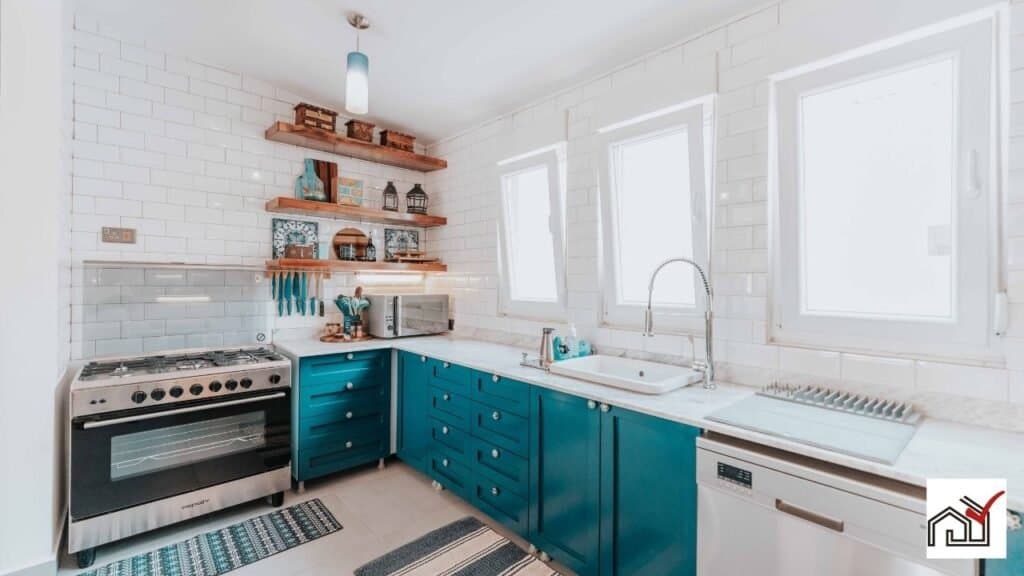Clean kitchen cabinets regularly to prevent buildup of grease, dust, and spills. Use an all-purpose cleaner or a mix of dish soap and warm water for effective cleaning.
For wooden cabinets, use special wood cleaners or cabinet creams to protect the finish. Choose cleaners suitable for the cabinet material, whether painted, laminate, or wood, to maintain appearance and durability.
Proper cleaning maintains both cleanliness and the look of kitchen cabinets.
Selecting the Right Cleaners
Choosing the right cleaner is important for keeping kitchen cabinets in good condition and looking their best. To avoid damage and maintain their appearance, consider the cabinet material and the dirt type before selecting a cleaner.
For daily cleaning, an effective grease-cutting all-purpose cleaner works well. Alternatively, a gentle option is a mix of dish soap and warm water, which removes most kitchen dirt without damaging the cabinet surface. For a natural choice, use a solution of white vinegar and warm water in a spray bottle, which cuts through grease and leaves a streak-free finish.
For tough stains, a paste of baking soda may be used. Apply it to the stain and rub gently with a soft cloth. Always use a clean cloth to prevent spreading dirt. Oil soap is recommended for wood cabinets, as it cleans without removing the wood’s natural oils.
During cleaning, avoid too much moisture to prevent finish damage. After cleaning, rinse the cabinets with a warm, damp cloth and dry them completely to protect the finish and prevent watermarks.
Everyday Cabinet Care
Regular kitchen cabinet maintenance can prevent the need for deep cleaning. Clean the exterior of your cabinets weekly with a damp cloth, followed by a dry microfiber cloth to remove any lingering moisture.
Promptly wipe up spills and splatters to avoid stubborn stains. Clean cabinets while cooking to reduce grease and grime buildup.
Occasionally, empty and thoroughly clean the inside of the cabinets to avoid hidden messes.
Regular care maintains a clean kitchen and extends the life of your cabinets.
Addressing Tough Grease
To clean stubborn grease on kitchen cabinets, mix mild dishwashing soap with hot water. The hot water helps to soften the grease, making it easier to remove. For persistent stains, use an old toothbrush dipped in the soapy mixture to scrub around handles and crevices.
For very resistant grease, make a paste with vegetable oil and baking soda. Apply it to the area, wait a few minutes, then scrub and wipe it off. Clean the cabinets thoroughly to remove any residue.
After cleaning, rinse the cabinets with a warm water-dampened cloth to remove all soap. Regular cleaning with these methods will maintain the appearance of your kitchen cabinets and prevent grease buildup.
Natural Cleaning Solutions
Natural cleaning solutions, such as a mix of dish soap and water or vinegar and water, can effectively clean kitchen cabinets. To make a simple cleaner, combine one part dishwashing soap with two parts hot water. This can remove grime and water stains. For tougher cleaning, mix one part distilled white vinegar with two parts hot water to break down grease and residue.
Use a soft cloth with these mixtures, making sure it’s damp but not too wet to prevent damage to the cabinet finish. Wipe surfaces with the cloth to clean without leaving streaks.
Warm water in these solutions helps soften grease for easier removal. Always consider the cabinet material when choosing a cleaning method. These natural options protect your cabinets and promote a healthier home.
Cleaning Different Materials
Kitchen cabinets require specific cleaning methods based on their material to ensure they last and look good.
For wood cabinets, use commercial cleaners like Murphy’s Oil Soap or a mix of vinegar and warm water in equal parts. Spray lightly on the cabinets and wipe with a soft cloth to avoid wood damage from too much moisture. Use finish-appropriate cleaners for finished wood and avoid soaking the surface.
When cleaning painted wood, be gentle to prevent paint damage. Wipe both inside and outside of cabinets with a soft cloth. For stubborn dirt, use a mild dish soap and hot water solution with a soft scrub pad. Dry the cabinets afterward to prevent water damage.
Use an old toothbrush to clean hard-to-reach designs or crevices gently.
For laminate cabinets, avoid excess water as they’re prone to water damage. Remove grease with a baking soda and water paste and then wipe with a damp cloth.
Always dry the cabinets after cleaning to maintain their condition.
Maintaining Cabinet Shine
To maintain the shine of kitchen cabinets, choose gentle cleaners like a mix of mild dish soap and hot water or white vinegar with hot water. These remove grease and fingerprints without damaging the finish.
Use a soft cloth for cleaning and avoid abrasive materials that can scratch surfaces. Rinse cabinets with a clean, damp cloth to remove any soap residue, which can dull the appearance.
Immediately dry cabinets with a dry cloth to prevent water damage or spots. For extra shine, buff with a soft cloth.
Regular cleaning, such as a weekly wipe-down, helps keep the cabinets shiny and your kitchen welcoming. This routine preserves the cabinets’ condition over time.





